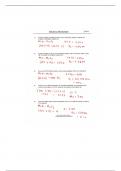Summary
Tort Law - Causation Summary
- Module
- Tort Law
- Institution
- Oxford University (OX)
Comprehensive summary/exam notes on the topic of causation in Tort Law. This document outlines the 'but for' test, the test for material contribution to injury, the test for material contribution to risk, failure to warn test, rules regarding recovery for loss of chance and rules regarding a break ...
[Show more]




